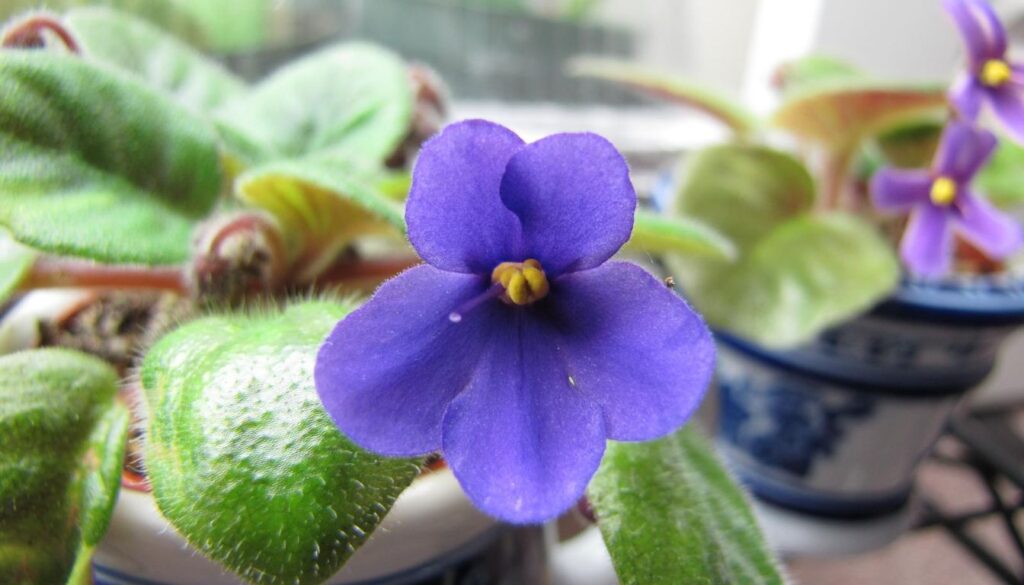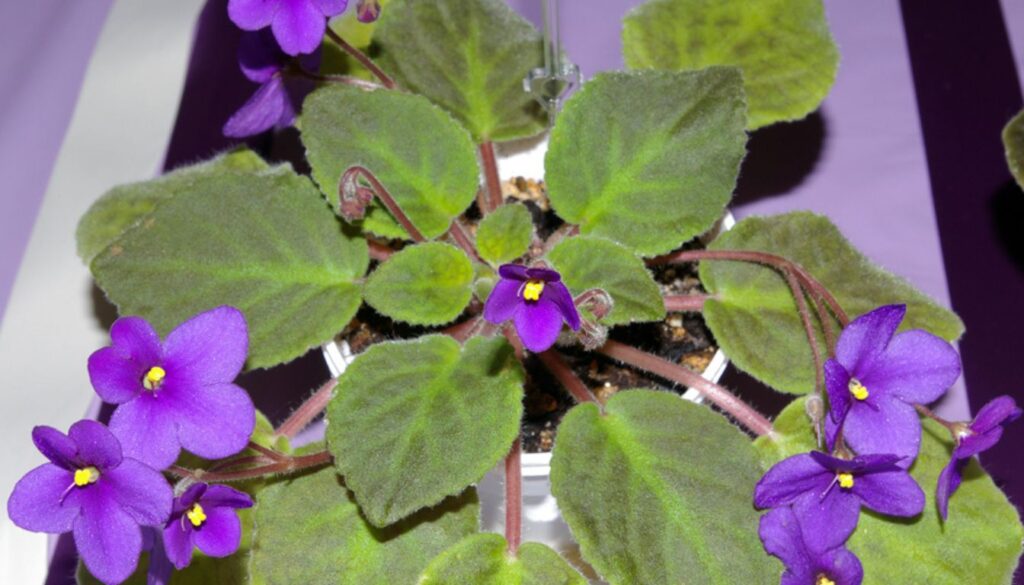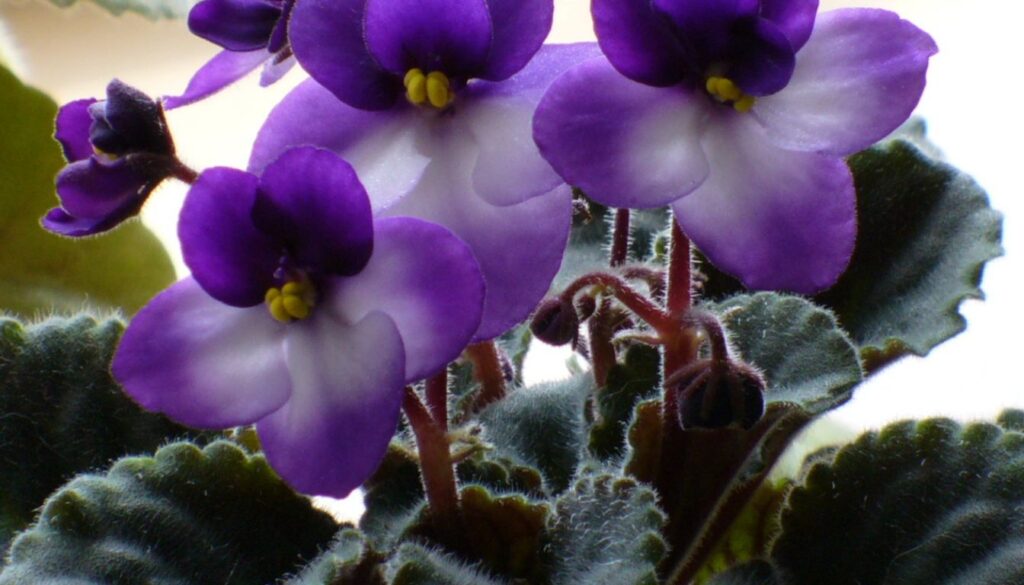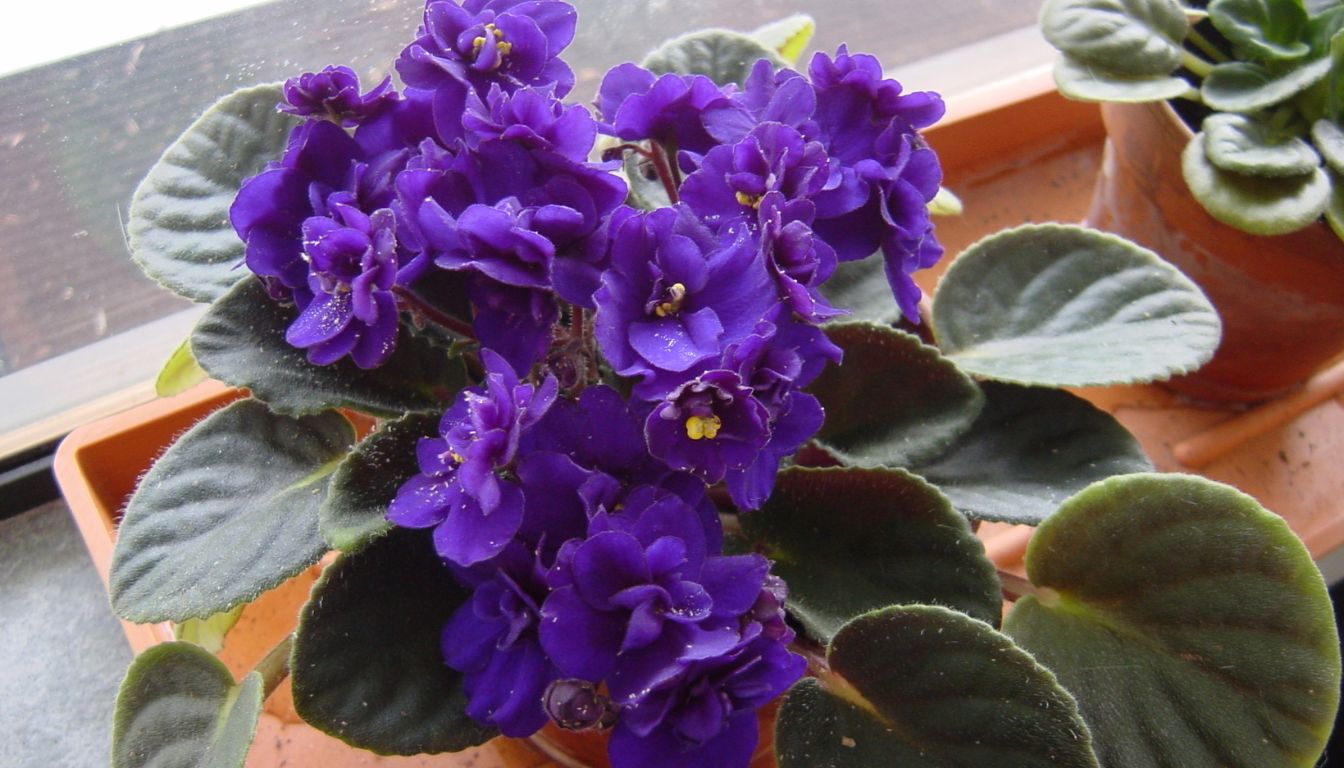African violets are popular houseplants because of their beautiful, delicate flowers and ease of care. However, a common problem is African violet leaves turning yellow. Yellow leaves can signal various issues, from natural ageing to nutrient deficiencies or overwatering.
As someone who has cared for African violets, I know how frustrating it can be to see yellow leaves on your plant. It’s important to understand the root cause of the issue to properly address it and prevent further damage to your plant. In this article, we will explore the various reasons why African violet leaves turn yellow, and provide tips on how to prevent and treat this issue. By the end of this article, you will have the knowledge you need to keep your African violets healthy and thriving.
Understanding African Violet Yellow Leaves
As a plant enthusiast, I know that African violets are one of the most popular indoor plants due to their beautiful flowers and ease of care. However, one common issue that many African violet owners face is yellowing leaves. In this section, I will provide you with some insights into why African violet leaves turn yellow, how to diagnose the problem, and what you can do to prevent it from happening.
Common Causes of Yellowing Leaves
African violet leaves can turn yellow due to various reasons, including:
- Watering issues: Overwatering or underwatering can cause African violet leaves to turn yellow. Overwatering can lead to root rot, which prevents the plant from absorbing nutrients, while underwatering can cause the leaves to dry out and turn yellow.
- Lighting: African violets require bright, indirect light to thrive. If they are placed in a location that receives too much or too little light, their leaves can turn yellow.
- Temperature: African violets prefer a temperature range of 65-75°F (18-24°C). If the temperature drops below or rises above this range, it can cause the leaves to yellow.
- Nutrient deficiency: African violets require specific nutrients to grow and thrive. If they are not getting enough nutrients, their leaves can turn yellow.
Symptoms and Diagnosis
To diagnose why your African violet leaves are turning yellow, you need to observe the plant closely and look for the following symptoms:
- Yellow leaves: If the lower leaves are turning yellow, it could be due to overwatering or underwatering. If the upper leaves are turning yellow, it may be due to too much or too little light.
- Brown spots: Brown spots on the leaves can be a sign of bacterial or fungal infection.
- Wilting leaves: Wilting leaves can be a sign of root rot, which is caused by overwatering.
If you notice any of these symptoms, you can diagnose the problem and take corrective action accordingly.
African violet leaves turning yellow can be a sign of various issues. By understanding the common causes and symptoms, you can diagnose the problem and take corrective action to keep your plant healthy and thriving.
Watering Practices and Yellow Leaves – African Violet Leaves Turn Yellow
As an African violet owner, I know that yellow leaves are one of the most common problems that can occur with these plants. One of the main causes of yellowing leaves is improper watering practices. In this section, I will discuss the effects of overwatering and underwatering, as well as proper watering techniques to prevent yellow leaves.
Effects of Overwatering – African Violet Leaves Turning Yellow
Overwatering is one of the most common causes of yellow leaves in African violets. When the soil is constantly wet, the roots can become waterlogged and deprived of oxygen. This can lead to root rot, which can cause the leaves to turn yellow and wilt. Additionally, overwatering can cause water droplets to form on the leaves, which can lead to yellow spots and even fungal growth.
Consequences of Underwatering
Underwatering can also cause yellow leaves in African violets. When the soil is too dry, the plant will start to wilt and the leaves will turn yellow. In extreme cases, the leaves may even fall off. Additionally, if the plant is not getting enough water, it may become more susceptible to pests and diseases.
Proper Watering Techniques
Proper watering techniques are essential for preventing yellow leaves in African violets. Here are some tips:
- Water the plant when the soil is dry to the touch, but not bone dry.
- Use room temperature water to avoid shocking the roots.
- Water the soil, not the leaves, to prevent water droplets from forming.
- Use a watering can with a long spout to water the soil directly.
- Make sure the pot has drainage holes to prevent water from pooling in the bottom.
By following these simple watering techniques, you can prevent yellow leaves in your African violets and keep your plants healthy and thriving.
Light and Temperature Factors – African Violet Leaves Turning Yellow
As an avid African violet enthusiast, I have learned that light and temperature play a crucial role in the health of these plants. In this section, I will discuss the impact of sunlight exposure and the optimal temperature for African violets.
Impact of Sunlight Exposure – African Violet Leaves Turning Yellow
African violets require a moderate amount of sunlight to thrive. Direct sunlight can cause the leaves to turn yellow and even burn. On the other hand, too little sunlight can cause the plant to grow leggy and produce fewer blooms. Therefore, it is important to provide your African violets with the right amount of sunlight.
To avoid direct sunlight, place your African violets in a location where they can receive indirect light. If you are growing your African violets indoors, placing them near a window with a sheer curtain can provide the right amount of light. Alternatively, you can use a grow light to provide the necessary light requirements.
It is also important to note that UV rays can be harmful to African violets. Therefore, it is recommended to avoid placing your plants near a window that receives direct sunlight, especially during the hottest part of the day.
Optimal Temperature for African Violets
African violets prefer a temperature range between 60-80°F (15-27°C). Temperatures outside of this range can cause the leaves to turn yellow and even drop off. Therefore, it is important to maintain a consistent temperature for your African violets.
If you are growing your African violets indoors, make sure to keep them away from drafts and air conditioning vents. These can cause sudden temperature changes that can stress the plant.
In addition, African violets can benefit from being placed in a humid environment. This can be achieved by placing a tray of water near the plant or using a humidifier.
By following these light and temperature guidelines, you can ensure that your African violets stay healthy and vibrant.
Soil and Fertilization – African Violet Leaves Turning Yellow

As I mentioned earlier, African violets are sensitive plants. They require a specific type of soil mix to grow correctly. Choosing the right soil mix for African violets is essential to prevent yellowing leaves.
Choosing the Right Soil Mix – African Violet Leaves Turning Yellow
African violets prefer a soil mix that is light, well-draining, and slightly acidic. A good soil mix for African violets should contain sphagnum peat moss, vermiculite, and perlite. Some gardeners also add a small amount of traditional potting soil to the mix.
Fertilizer Use and Misuse
Fertilizer is essential for African violets to grow and thrive. However, overfertilization can lead to yellowing leaves. When fertilizing African violets, it is crucial to follow the instructions on the fertilizer package. Overfertilizing can cause salt buildup in the soil, which can lead to nutrient deficiencies.
African violets require a balanced fertilizer that contains equal amounts of nitrogen, phosphorus, and potassium. Fertilize your African violets once a month during the growing season. Avoid fertilizing during the winter months when African violets are dormant.
Soil problems and overfertilization can cause yellowing leaves in African violets. Choosing the right soil mix and using fertilizer correctly can prevent yellowing leaves.
Disease and Pest Management – African Violet Leaves Turning Yellow
As an African violet owner, it is important to be aware of common pests and diseases that can affect your plant. By identifying and dealing with these issues early, you can prevent them from causing serious damage.
Identifying Common Pests – African Violet Leaves Turning Yellow
Aphids, mealybugs, plant scales, spider mites, and thrips are common pests that can infest African violets. These pests can cause damage to the leaves and flowers, and can even kill the plant if left untreated.
Aphids are small, pear-shaped insects that feed on the sap of the plant. They can be identified by their soft, green bodies and long legs. Mealybugs are small, white insects that resemble cotton balls. They can be found on the leaves, stems, and flowers of the plant. Plant scales are small, oval-shaped insects that can be found on the underside of the leaves. Spider mites are tiny, spider-like insects that can cause damage to the leaves and flowers. Thrips are small, slender insects that feed on the sap of the plant.
Dealing with Diseases
Fungal diseases can also affect African violets. Ring spot is a common fungal disease that can cause yellowing of the leaves and rings on the stems. Infection can spread quickly and cause the plant to wilt and die. It is important to remove any infected leaves or flowers and treat the plant with a fungicide.
Neem oil is a natural pesticide that can be used to treat pests and diseases. It is effective against aphids, mealybugs, spider mites, and thrips. Simply mix a small amount of neem oil with water and spray the plant.
Pesticides can also be used to treat pests and diseases. However, it is important to read the label carefully and follow the instructions. Overuse of pesticides can harm the plant and the environment.
It is important to be vigilant and take action if you notice any signs of pest infestation or disease. By identifying and dealing with these issues early, you can help your African violet thrive.
Environmental Stress and Plant Care

As an avid gardener and African violet enthusiast, I have learned that environmental stress can cause African violet leaves to turn yellow. There are several factors that can contribute to environmental stress in African violets, including humidity, air circulation, and pruning.
Humidity and African Violet Health – African Violet Leaves Turning Yellow
Maintaining proper humidity levels is crucial for the health of African violets. Low humidity can cause the leaves to become dry and brittle, while high humidity can lead to fuzzy leaves and stunted blossoms. To maintain optimal humidity levels, I recommend using a humidifier or placing a tray of water near the plant. It is important to avoid misting the leaves directly, as this can cause water droplets to collect and lead to fungal growth.
Maintaining Proper Air Circulation
Proper air circulation is also important for the health of African violets. Stagnant air can cause the leaves to become weak and prone to disease. To ensure proper air circulation, I recommend placing a small fan near the plant or opening a nearby window. It is important to avoid placing the plant near air conditioning or heating vents, as this can cause the leaves to become too dry.
Pruning and Plant Maintenance
Pruning and plant maintenance are also important for the health of African violets. Regular pruning can help to promote healthy growth and prevent the plant from becoming too leggy. To prune the plant, I recommend using sharp, clean scissors to remove any dead or damaged leaves and stems. It is also important to check the root health of the plant periodically and to replant it as needed.
Environmental stress can cause African violet leaves to turn yellow. By maintaining proper humidity levels, air circulation, and pruning, you can help to ensure the health of your African violet plant. Remember to check the root health of the plant periodically and to replant it as needed to prevent natural plant aging.
Advanced Care Techniques – African Violet Leaves Turning Yellow
As an avid African violet grower, I have found that advanced care techniques can help prevent yellowing leaves and promote healthy growth. Here are some techniques that have worked for me:
Repotting and Root Care
Repotting your African violet every six months to a year is essential for maintaining healthy roots and preventing root rot. When repotting, use a well-draining soil mix that is specifically formulated for African violets. A mix of peat moss, vermiculite, and perlite is a good choice.
When removing the plant from its current pot, be gentle with the roots and try to keep as much of the existing soil intact as possible. If you notice any signs of root rot, such as a foul odor or black, mushy roots, remove the affected roots and repot the plant in fresh soil.
Specialized Equipment for African Violets – African Violet Leaves Turning Yellow
Investing in specialized equipment can make a big difference in the health of your African violets. Here are a few items that I have found to be particularly helpful:
- Grow lights: African violets require bright, indirect light to thrive. If you don’t have a sunny window, a grow light can provide the necessary light for healthy growth.
- Special watering cans: African violets are sensitive to water, and getting water on their leaves can cause yellowing. A watering can with a long, narrow spout can help you water the soil directly without getting water on the leaves.
- Saucer filled with pebbles: Placing your African violet in a saucer filled with pebbles can help increase humidity around the plant, which is beneficial for growth.
- Perlite: Adding perlite to your soil mix can help improve drainage and prevent root rot.
By using these advanced care techniques, you can help prevent yellowing leaves and promote healthy growth in your African violets.
Troubleshooting Specific Leaf Conditions

When it comes to African violet leaves turning yellow, there are a few specific leaf conditions that you may encounter. In this section, I will discuss how to address fuzzy or brown leaves, as well as how to prevent necrotic spots and discoloration.
Addressing Fuzzy or Brown Leaves
If you notice that your African violet leaves are turning fuzzy or brown, this could be a sign of a fungal or bacterial infection. To address this issue, you should remove any affected leaves immediately to prevent the infection from spreading. You should also avoid getting water on the leaves, as this can create a moist environment that is conducive to fungal growth.
To prevent fungal or bacterial infections, it is important to keep your African violets in a well-ventilated area with good air circulation. You should also avoid overcrowding your plants, as this can lead to increased humidity and moisture levels. Additionally, you can use a fungicide or bactericide to treat and prevent infections.
Preventing Necrotic Spots and Discoloration – African Violet Leaves Turning Yellow
Necrotic spots and discoloration on African violet leaves can be caused by a variety of factors, including overwatering, underwatering, nutrient deficiencies, and exposure to direct sunlight. To prevent these issues, it is important to provide your African violets with the proper care and growing conditions.
First, make sure that you are watering your plants correctly. African violets prefer to be slightly moist, but not waterlogged. You should also make sure that your plants are getting enough light, but not too much direct sunlight. If you notice that your plants are getting too much sun, you can move them to a shadier location or provide them with some shade cloth.
In addition to proper watering and lighting, you should also make sure that your African violets are getting the right nutrients. You can use a balanced fertilizer specifically designed for African violets to ensure that your plants are getting the nutrients they need to thrive.
By addressing these specific leaf conditions and providing your African violets with the proper care, you can prevent yellowing and other issues from occurring.
Don’t forget to add theherbprof.com to your favourites so you don’t miss out on future articles!
References – African Violet Leaves Turning Yellow
Little Herb Encyclopedia, by Jack Ritchason; N.D., Woodland Publishing Incorporated, 1995
The Ultimate Healing System, Course Manual, Copyright 1985, Don Lepore
Planetary Herbology, Michael Tierra, C.A., N.D., Lotus Press, 1988
Handbook of Medicinal Herbs, by James A. Duke, Pub. CRP Second Edition 2007
The Complete Medicinal Herbal, by Penelope Ody, Published by Dorling Kindersley
Check the Following Articles!
Watering Mint Indoors: Tips for Healthy Growth
Best Grow Lights for Succulents: Let Me Show You How!
Lavender Die Back: Causes, Prevention, and Treatment
Frequently Asked Questions – African Violet Leaves Turning Yellow
What causes the yellowing of African Violet leaves?
Yellowing of African Violet leaves can be caused by a variety of factors, including overwatering, underwatering, lack of nutrients, too much direct sunlight, or too little light. It is important to identify the root cause of the yellowing in order to properly address the issue.
How should African Violets be fertilized to prevent yellow leaves?
African Violets should be fertilized regularly with a balanced fertilizer that is specifically formulated for these plants. It is important to follow the instructions on the fertilizer package and not to over-fertilize, as this can lead to yellowing of the leaves.
Is it necessary to remove yellow leaves from African Violets?
Yes, it is important to remove yellow leaves from African Violets in order to promote healthy growth and prevent the spread of disease. Yellow leaves can also be a sign of overwatering or underwatering, so removing them can help prevent further damage to the plant.
What are the signs of overwatering in African Violets?
Signs of overwatering in African Violets include yellowing leaves, wilting, and root rot. It is important to allow the soil to dry out slightly between waterings and to ensure that the plant is not sitting in standing water.
How can I tell if my African Violet is getting too much or too little light?
If an African Violet is getting too much light, its leaves may become yellow or brown and may appear scorched. If it is not getting enough light, its leaves may become pale or may appear to be stretching towards the light source. African Violets thrive in bright, indirect light.
What type of soil is best for maintaining healthy African Violet leaves?
African Violets prefer well-draining soil that is rich in organic matter. A soil mix that is specifically formulated for African Violets is ideal. It is important to avoid using heavy soils or soils that retain too much moisture, as this can lead to root rot and yellowing of the leaves.

